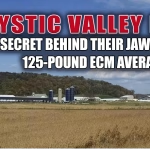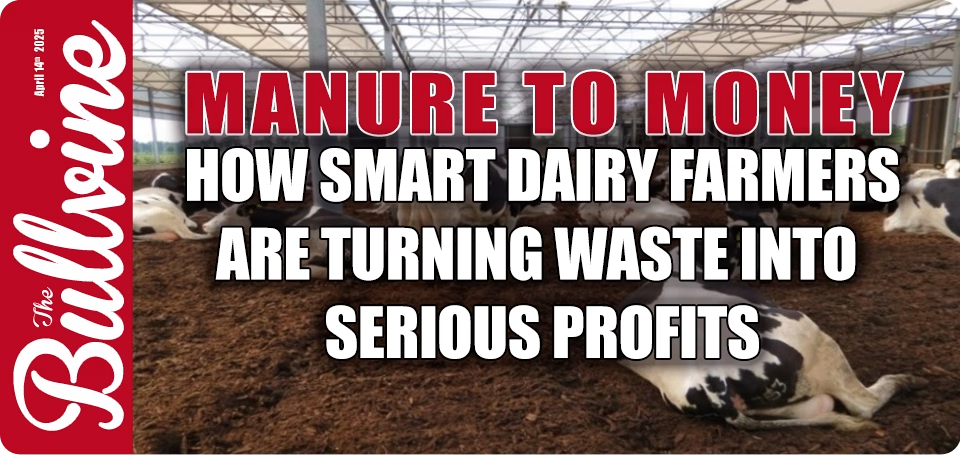Latest News
 Beyond Blocks and Blades: Why Your Lameness Treatment Protocol Is Missing a Critical ComponentNew research: Adding NSAIDs to lameness treatment boosts dairy cow fertility by 42% while improving recovery. Are your protocols outdated? EXECUTIVE SUMMARY: Cl […]
Beyond Blocks and Blades: Why Your Lameness Treatment Protocol Is Missing a Critical ComponentNew research: Adding NSAIDs to lameness treatment boosts dairy cow fertility by 42% while improving recovery. Are your protocols outdated? EXECUTIVE SUMMARY: Cl […] March Milk Meltdown: The Hard Truth About FMMO Price DeclinesMilk prices CRASHED in all 11 FMMO regions March 2025—butterfat hits 3-year low. Survival strategies for dairy farmers inside. Are you prepared? EXECUTIVE SUMMA […]
March Milk Meltdown: The Hard Truth About FMMO Price DeclinesMilk prices CRASHED in all 11 FMMO regions March 2025—butterfat hits 3-year low. Survival strategies for dairy farmers inside. Are you prepared? EXECUTIVE SUMMA […] CME Dairy Market Report: April 16, 2025 – Cheddar Blocks Surge While Barrels Reverse Course; Butter Continues Decline Amid Stable Powder MarketsCheese markets split as blocks surge and barrels tumble; butter slides further while global signals flash warning signs for US producers. EXECUTIVE SUMMARY: The […]
CME Dairy Market Report: April 16, 2025 – Cheddar Blocks Surge While Barrels Reverse Course; Butter Continues Decline Amid Stable Powder MarketsCheese markets split as blocks surge and barrels tumble; butter slides further while global signals flash warning signs for US producers. EXECUTIVE SUMMARY: The […] Double-Ovsynch or Double E-Synch? Which Fertility Program Will Boost Your Herd’s Pregnancy Rates?Double E-Synch rivals Double-Ovsynch! New research shows 10% fertility boost in high-producing cows & 86hrs/year labor savings. Game-changer? Executive Summ […]
Double-Ovsynch or Double E-Synch? Which Fertility Program Will Boost Your Herd’s Pregnancy Rates?Double E-Synch rivals Double-Ovsynch! New research shows 10% fertility boost in high-producing cows & 86hrs/year labor savings. Game-changer? Executive Summ […] AI Eyes on Your Herd: Why Automated Lameness Detection Is Revolutionizing Dairy FarmingAI spots lame cows 23 days before humans. Dairy farmers: Is your herd's $500/cow/year profit drain hiding in plain sight? EXECUTIVE SUMMARY: Automated 2D imagin […]
AI Eyes on Your Herd: Why Automated Lameness Detection Is Revolutionizing Dairy FarmingAI spots lame cows 23 days before humans. Dairy farmers: Is your herd's $500/cow/year profit drain hiding in plain sight? EXECUTIVE SUMMARY: Automated 2D imagin […]
More News
- The Impact of Tariffs on Global Dairy Demand: A Sector Under Pressure
- Protein Power Play: How Dairy Can Dominate The GLP-1 Revolution
- Dairy Profit Squeeze 2025: Why Your Margins Are About to Collapse (And What to Do About It)
- CME Dairy Report: Cheese Barrels Surge to Rare Premium Over Blocks as Markets Show Strength
- Tariffs: The Hidden Hand Milking Your Bottom Line
- Global Dairy Trade Surges 1.6%: Lactose Skyrockets 22% While Powder Markets Falter
- Winning the Weed Chess Game: Why Your Dairy Farm’s Bottom Line Depends on Smarter Strategies
- 84% TARIFF SHOCK: How the US-China Trade War Will Reshape Your Dairy Business
- Is Your Herd Safe? Cybersecurity Essentials for Modern Dairy Farms
- Dairy Titans Unite: Arla-DMK Merger Reshapes Europe’s Dairy Landscape
Top News Posts from Past Week
- Double-Ovsynch or Double E-Synch? Which Fertility Program Will Boost Your Herd’s Pregnancy Rates?
- Dairy’s Golden Calf Rush: $1,000+ Crossbreds Reshape Farm Economics
- The $1,000 Calves & $4,000 Springers: How Long Will This Gravy Train Keep Rolling?
- Milk Tsunami Ahead: USDA Exposes 2025 Price Crash Triggers
- Trump’s $998-A-Day Migrant Fines: Is it a Death Sentence for America’s Dairy Industry?
- Mega-Dairy Revolution: Inside the World’s 10 Largest Dairy Farms
- Dairy Titans Unite: Arla-DMK Merger Reshapes Europe’s Dairy Landscape
- $4,000 Heifer Shock: Replacement Heifer Prices Reach Record Territory
- March Milk Meltdown: The Hard Truth About FMMO Price Declines
- 84% TARIFF SHOCK: How the US-China Trade War Will Reshape Your Dairy Business
Feature Articles
 Expo-Printemps 2025 – HolsteinApril 17th, 2025 @ Victoriaville QC Grand Champion PIERSTEIN DEVOUR ROSHA Grand Champion Quebec Spring Holstein Show 2025 PIERRE BOULET, MONTMAGNY, QC Grand - P […]
Expo-Printemps 2025 – HolsteinApril 17th, 2025 @ Victoriaville QC Grand Champion PIERSTEIN DEVOUR ROSHA Grand Champion Quebec Spring Holstein Show 2025 PIERRE BOULET, MONTMAGNY, QC Grand - P […] Expo-Printemps 2025 – Red & White HolsteinApril 17th, 2025 @ Victoriaville QC Winter Calf Née entre le 1er décembre 2024 et le 28 février 2025 FORTOISE ALTITUDE JESSY-RED, HOCANF121950298Propriété-élevé […]
Expo-Printemps 2025 – Red & White HolsteinApril 17th, 2025 @ Victoriaville QC Winter Calf Née entre le 1er décembre 2024 et le 28 février 2025 FORTOISE ALTITUDE JESSY-RED, HOCANF121950298Propriété-élevé […] Hearts of the Heartland: Young Dairy Farm Girls’ Extraordinary Battles for LifeYoung dairy farm girls Lexi, Reese & Sydni defy death through transplants, fire recovery & paralysis—proving resilience rooted in rural communities and […]
Hearts of the Heartland: Young Dairy Farm Girls’ Extraordinary Battles for LifeYoung dairy farm girls Lexi, Reese & Sydni defy death through transplants, fire recovery & paralysis—proving resilience rooted in rural communities and […] 5 Powerful Stress-Busting Techniques Every Dairy Farmer Needs This SpringBeat spring burnout! 5 science-backed strategies dairy farmers use to survive calving season and thrive. Mental health = farm health. E236 5 Powerful Stress-Bus […]
5 Powerful Stress-Busting Techniques Every Dairy Farmer Needs This SpringBeat spring burnout! 5 science-backed strategies dairy farmers use to survive calving season and thrive. Mental health = farm health. E236 5 Powerful Stress-Bus […] Mystic Valley Dairy: The Secret Behind Their Jaw-Dropping 125-Pound ECM AverageWisconsin's Mystic Valley Dairy shatters records with 125 pounds of energy-corrected milk daily. Discover how "doing 100 little things right" creates extraordin […]
Mystic Valley Dairy: The Secret Behind Their Jaw-Dropping 125-Pound ECM AverageWisconsin's Mystic Valley Dairy shatters records with 125 pounds of energy-corrected milk daily. Discover how "doing 100 little things right" creates extraordin […]
More Articles
- Expo-Printemps 2025 – Holstein
- Expo-Printemps 2025 – Red & White Holstein
- Hearts of the Heartland: Young Dairy Farm Girls’ Extraordinary Battles for Life
- 5 Powerful Stress-Busting Techniques Every Dairy Farmer Needs This Spring
- Mystic Valley Dairy: The Secret Behind Their Jaw-Dropping 125-Pound ECM Average
- MANURE TO MONEY: How Smart Dairy Farmers Are Turning Waste into Serious Profits
- Hanoverhill Starbuck’s DNA Dynasty: The Holstein Legend Bridging 20th-Century Breeding to Genomic Futures
- Revolutionary Colostrum Protocol Adding $500 Per Heifer to Your Bottom Line
- 2024 Holstein Canada Master Breeders: Excellence in Balance, Breeding, and Legacy
- Dad at 80: How Murray Hunt Revolutionized Canadian Dairy Genetics
Top Feature Articles from the Past Month
- Expo-Printemps 2025 – Holstein
- Top 15 Best Milk Brands in the USA: Unveiling the Cream of the Crop
- Northeast Spring National Holstein Show 2025
- The Cow That Built an Empire: Comestar Laurie Sheik’s Unstoppable Genetic Legacy
- Hanoverhill Starbuck’s DNA Dynasty: The Holstein Legend Bridging 20th-Century Breeding to Genomic Futures
- 10 Sires To Breed The Next World Dairy Expo Grand Champion
- Why Donald Trump Hates Canada’s Dairy Supply System
- CAPTAIN: The Bull That Rewrote the Rules for Modern Breeding
- Making Dreams Come True: The Journey of Tom & Kelli Cull
- The $4,300 Gamble That Reshaped Global Dairy Industry: The Pawnee Farm Arlinda Chief Story
- Expo-Printemps 2025 - Holstein
-
Expo-Printemps 2025 – Holstein
Andrew Hunt Apr 17, 2025April 17th, 2025 @ Victoriaville QC Grand Champion PIERSTEIN DEVOUR ROSHA Grand Champion Quebec Spring Holstein Show 2025 PIERRE BOULET, MONTMAGNY, QC Grand - PIERSTEIN DEVOUR ROSHA - PIERRE BOULET, MONTMAGNY, QCReserve - JACOBS UNIX CARFUL - FERME JACOBS INC, … Read More - Expo-Printemps 2025 - Red & White Holstein
-
Expo-Printemps 2025 – Red & White Holstein
Andrew Hunt Apr 17, 2025April 17th, 2025 @ Victoriaville QC Winter Calf Née entre le 1er décembre 2024 et le 28 février 2025 FORTOISE ALTITUDE JESSY-RED, HOCANF121950298Propriété-élevéeFERME FORTOISE INC, SAINT-PIERRE-BAPTISTE, QC MALIC ALTITUDE DESTINY-RED, HOCANF121853806FERME MALIC, PONDEROSA HOLS… Read More
- Hearts of the Heartland: Young Dairy Farm Girls' Extraordinary Battles for Life
-
Hearts of the Heartland: Young Dairy Farm Girls’ E…
Andrew Hunt Apr 16, 2025Young dairy farm girls Lexi, Reese & Sydni defy death through transplants, fire recovery & paralysis—proving resilience rooted in rural communities and dairy cattle bonds. E237 Hearts of the Heartland: Young Dairy Farm Gir | RSS.com When discussing strength in the dairy industry, the… Read More
- 5 Powerful Stress-Busting Techniques Every Dairy Farmer Needs This Spring
-
5 Powerful Stress-Busting Techniques Every Dairy F…
Andrew Hunt Apr 16, 2025Beat spring burnout! 5 science-backed strategies dairy farmers use to survive calving season and thrive. Mental health = farm health. E236 5 Powerful Stress-Busting Techniques Every Da | RSS.com Spring brings more than just new growth to your dairy operation—it delivers a perfect storm of str… Read More
- Mystic Valley Dairy: The Secret Behind Their Jaw-Dropping 125-Pound ECM Average
-
Mystic Valley Dairy: The Secret Behind Their Jaw-D…
Karen Hunt Apr 15, 2025Wisconsin's Mystic Valley Dairy shatters records with 125 pounds of energy-corrected milk daily. Discover how "doing 100 little things right" creates extraordinary results. E235 Mystic Valley Dairy: The Secret Behind Their | RSS.com Ever wonder what it takes to run a dairy farm where cows pr… Read More
- MANURE TO MONEY: How Smart Dairy Farmers Are Turning Waste into Serious Profits
-
MANURE TO MONEY: How Smart Dairy Farmers Are Turni…
Andrew Hunt Apr 14, 2025Dairy farmers are flushing away $15,000 per 100 cows annually. Discover how savvy producers are turning manure into a goldmine through strategic composting. E234 MANURE TO MONEY: How Smart Dairy Farmers Are | RSS.com While your neighbors complain about your farm's smell and regulators circle… Read More
- Hanoverhill Starbuck's DNA Dynasty: The Holstein Legend Bridging 20th-Century Breeding to Genomic Futures
-
Hanoverhill Starbuck’s DNA Dynasty: The Holstein L…
Andrew Hunt Apr 12, 2025From $2,500 calf to genetic revolution: How one bull's DNA reshaped global dairy farming and still whispers in 83% of Holsteins today. E233 Hanoverhill Starbuck’s DNA Dynasty: The Holst | RSS.com The legendary Hanoverhill Starbuck, pictured here at 5 years old by photographer Jim Rose, stands… Read More
- Revolutionary Colostrum Protocol Adding $500 Per Heifer to Your Bottom Line
-
Revolutionary Colostrum Protocol Adding $500 Per H…
Andrew Hunt Apr 11, 2025Are you discarding liquid gold? Discover how extended colostrum feeding adds $500 per heifer while slashing treatment costs and boosting lifetime milk. E232 Revolutionary Colostrum Protocol Adding $500 | RSS.com Your current calf feeding program may be limiting your profitability by up to $5… Read More
- 2024 Holstein Canada Master Breeders: Excellence in Balance, Breeding, and Legacy
-
2024 Holstein Canada Master Breeders: Excellence i…
Andrew Hunt Apr 10, 202519 Canadian dairy farms earn elite 2024 Master Breeder status—discover the secrets behind their balanced breeding success! E230 2024 Holstein Canada Master Breeders: Excelle | RSS.com The Holstein Canada Master Breeder shield represents the pinnacle of achievement in dairy cattle breeding – a… Read More
- Dad at 80: How Murray Hunt Revolutionized Canadian Dairy Genetics
-
Dad at 80: How Murray Hunt Revolutionized Canadian…
Andrew Hunt Apr 9, 2025At 80, Murray Hunt’s dairy genetics innovations still shape global herds—meet the visionary who made science the farmer’s ally. E229 Dad at 80: How Murray Hunt Revolutionized Can | RSS.com My father Murray Hunt at 80: The quiet visionary who transformed Canadian dairy breeding with scientific… Read More
Tanbark Trail
 Expo-Printemps 2025 – HolsteinApril 17th, 2025 @ Victoriaville QC Grand Champion PIERSTEIN DEVOUR ROSHA Grand Champion Quebec Spring Holstein Show 2025 PIERRE BOULET, MONTMAGNY, QC Grand - PIERSTEIN DEVOUR ROSHA - PIERRE BOULET, MONTMAGNY, QCReserve - JACOBS UNIX CARFUL -&nb […]
Expo-Printemps 2025 – HolsteinApril 17th, 2025 @ Victoriaville QC Grand Champion PIERSTEIN DEVOUR ROSHA Grand Champion Quebec Spring Holstein Show 2025 PIERRE BOULET, MONTMAGNY, QC Grand - PIERSTEIN DEVOUR ROSHA - PIERRE BOULET, MONTMAGNY, QCReserve - JACOBS UNIX CARFUL -&nb […] Expo-Printemps 2025 – Red & White HolsteinApril 17th, 2025 @ Victoriaville QC Winter Calf Née entre le 1er décembre 2024 et le 28 février 2025 FORTOISE ALTITUDE JESSY-RED, HOCANF121950298Propriété-élevéeFERME FORTOISE INC, SAINT-PIERRE-BAPTISTE, QC MALIC ALTITUDE DESTINY-RED, HOCANF121853806 […]
Expo-Printemps 2025 – Red & White HolsteinApril 17th, 2025 @ Victoriaville QC Winter Calf Née entre le 1er décembre 2024 et le 28 février 2025 FORTOISE ALTITUDE JESSY-RED, HOCANF121950298Propriété-élevéeFERME FORTOISE INC, SAINT-PIERRE-BAPTISTE, QC MALIC ALTITUDE DESTINY-RED, HOCANF121853806 […]Northeast Spring National Holstein Show 2025
March 31st, 2025 @ Hamburg, NY E217 Northeast Spring National Holstein Show 2025 | RSS.com The New York Spring Holstein Show, judged by Ryan Krohlow, showcased exceptional dairy cattle across multiple age divisions. The competition featured remarkabl […]Is Erbacers Snapple Shakira One of the Greatest Show Cows of All Time?
Uncover why Erbacres Snapple Shakira stands among the top dairy show cows of all time. What makes her excel in the competitive dairy arena? E55 Is Erbacers Snapple Shakira One of the Greatest Show Cows of All Time? From the moment she steps into the […]The Royal Winter Fair 2024 – Jersey
Judge Jeff Sales NTENSE JOEL DELPHIE ETGrand ChampionThe Royal - Jersey Show 2024WEEKSDALE/HI-CALIBER/ROCK ALLEN/F&D BORBA, BREADALBANE, PE c LEACHLAND VIDEO MOCHA K Intermediate Champion The Royal - Jersey Show 2024 WEEKSDALE HOLSTEINS, BRE […]
The Bullvine LLC © 2025 | Terms of Use | Community Guidelines | Privacy Policy |
Manage Consent
To provide the best experiences, we use technologies like cookies to store and/or access device information. Consenting to these technologies will allow us to process data such as browsing behavior or unique IDs on this site. Not consenting or withdrawing consent, may adversely affect certain features and functions.
Functional Always active
The technical storage or access is strictly necessary for the legitimate purpose of enabling the use of a specific service explicitly requested by the subscriber or user, or for the sole purpose of carrying out the transmission of a communication over an electronic communications network.
Preferences
The technical storage or access is necessary for the legitimate purpose of storing preferences that are not requested by the subscriber or user.
Statistics
The technical storage or access that is used exclusively for statistical purposes.
The technical storage or access that is used exclusively for anonymous statistical purposes. Without a subpoena, voluntary compliance on the part of your Internet Service Provider, or additional records from a third party, information stored or retrieved for this purpose alone cannot usually be used to identify you.
Marketing
The technical storage or access is required to create user profiles to send advertising, or to track the user on a website or across several websites for similar marketing purposes.



















